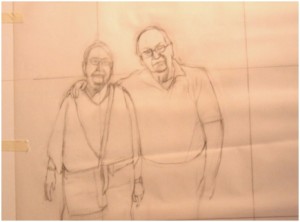If I had ten dollars for every time I heard “I’d love to paint but I can’t even draw a straight line” I would have a tidy sum, by now.
The fact is that in order to paint you should have some degree of competence in draughtsmanship; that’s a given. It is also a fact that like any other skills, it can be learnt if there is the desire to learn it.
Sure there are ‘naturals’ in all fields ; we all knew a kid at school who could draw so well that he drew recognisable caricatures of the teachers,but there were also those who could kick a ball better than the rest of us or had better marks in everything. They were the natural athletes, mathematical geniuses and natural draughtsmen like Matisse.
Most of us don’t belong to these categories, but we can all be at least proficient if we are prepared to work at it. To me a competent draughtsman is a person who could express in visual terms his creative ideas.
When I formulate my concepts I start with a few postage stamp sized scribbles and follow it up with some larger, more detailed sketches. These are not pretty or finished drawings just thoughts and experiments in composition and colour.
And when I begin to feel (yes, feelings are important for an artist) that I am getting close to my concepts I start to draw seriously. My favourite drawing surface, which I can recommend to all artists, is tracing paper. Tracing papers come in different weights, thicknesses and transparencies and only by experimenting can you find which one suits you. The best to start with would be in the middle of the range.
Tracing paper is very user-friendly. Corrections are easily made with a kneadable artists’ rubber at any stage of the drawing. Pencils of all degrees of softness or hardness are suitable. My personal favourites are soft pencils between 4 to 6B and I often use my fingers for modelling the tones. This is quite easy because the soft graphite glides over the smooth surface of the tracing paper.
Because of the translucent nature of the tracing paper one can test the composition and placement by moving it around on the intended painting surface and when you decided on the right spot, trace it on.
Tracing paper may not be every body’s cup of tea, but if you haven’t tried it before as a drawing surface do so now. You may be pleasantly surprised.
This is an early stage pencil study on tracing paper of a self-portrait with my wife.

Note that I drew a grid on the canvas under the tracing paper which helps in positioning the figures before the final tracing.
